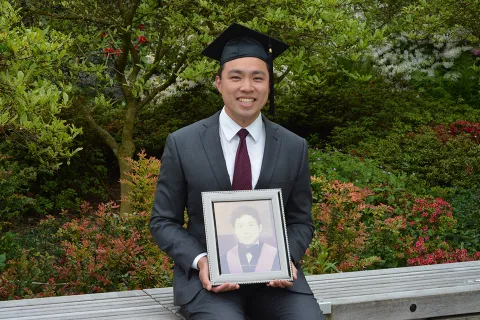UBC Engineering grad plans to channel passion for AI to innovate health-care
When UBC Engineering student Tyler Ga Wei Lum crosses the stage to accept his degree this week, his late uncle won’t be far from his thoughts.

Lum’s uncle, James Gee Mun Leong, moved to Canada over 60 years ago from southern China. It was a difficult journey for Leong, who left behind his family in order to build a new life in a new country with a different culture and language. His uncle was able to work through these challenges and eventually sponsor the rest of the family to immigrate to Canada as well.
Despite his uncle making a significant impact on his life, Lum never had the opportunity to meet him.
“He passed away quite young from a cancer that was detected too late,” says Lum, who will be graduating with a Bachelor of Applied Science in Engineering Physics.
“It's really sad and unfortunate. I've only seen pictures of him and heard how my family talks about him. He always made an effort to impart good values to our family. Even when he was busy trying to make ends meet, he would still find time to help my parents transition to living independently in Canada, and organized big dinners to bring our large extended family together."
Today, Lum says his uncle’s legacy inspires him to apply what he learned at UBC to innovate healthcare. Lum believes that he can use robotics and artificial intelligence (AI) to solve problems in the infrastructure of public health-care, including using AI to improve medical imaging so that diseases like cancer can be detected more quickly and easily.
“Robotics and AI are so interesting to me because I can see this area having a significant impact in health-care. With this technology, we could potentially help anybody scan for cancer quickly without even taking doctor's time,” he says. “That kind of dream really motivates me.”
Already, Lum has used his expertise in robotics and AI to help make COVID-19 detection more accessible and simpler. In the early days of the pandemic, the accessibility of COVID-19 testing in rural communities posed a significant challenge. Lum and his team came up with the idea of using deep learning AI on lung ultrasound radios to detect lung diseases, such as COVID-19 or other pneumonia.
Lum imagines this could lead to the creation of portable ultrasounds transducer that can easily identify the care needed for people.
“I was excited to use my passion for technical AI mathematics to potentially solve a very real-world problem. I think this is one of the very first steps to building these kinds of AI systems for health-care,” says Lum. “Once we've completed building this, it won't just help one hospital but the same technology can be used across the world to serve patients.”
During his time at UBC, Lum, who is from Burnaby, won an HSBC Emerging Leader Scholarship for his leadership, community service, participation in local and/or global communities and high academic achievement. He was also residence advisor and interned at Tesla as an autopilot software engineer.
“It was a really cool experience working at Tesla and seeing so many cutting-edge technologies being put into a system used by real-world users and on streets today,” Lum says.
For the last three years at UBC, Lum has been leading a multidisciplinary software team to build Sailbot—the world's first fully autonomous robotic sailboat that is attempting to sail from Victoria to Maui.
After graduation, Lum will be interning with Nvidia, a software company that specializes in artificial intelligence. He will then begin studies at Stanford University as he pursues his PhD in computer science to study deep learning methods for intelligent and adaptable robots.
This article originally appeared on UBC News.


